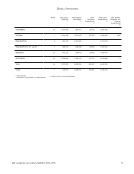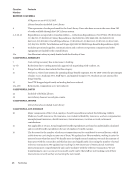34 ARL Statistics Questionnaire Instructions and Worksheet
2
© 2015 Association of Research Libraries, Washington, DC
ARL libraries are distinguished by the breadth and quality of their collections and services. They are also
recognized for their distinctive contributions to the aggregate of research resources in North America, in a variety
of media. As such, research library collections are key assets for individual institutions and for the
nation. Through individual and cooperative efforts, research libraries strive to preserve the record of knowledge
in ARL collections into the future. With the move from print to digital, libraries are providing stewardship not
only by the amount of local investments but also by the depth of their collaborations in establishing and
supporting shared collections.
The goal of capturing information on content indicators like ‘titles’ for the purposes of the ARL Statistics annual
data collection is tied to the mission of ARL in that it tries to provide good yet practical-to-collect indicators for
the rich scholarly resources ARL member libraries make available.
COLLECTIONS:
Question 1. Titles Held. Report all the instances of titles managed and maintained by the library including
cataloged, locally digitized, and licensed resources. Counting the 245 field when the library provides stewardship
for those resources may be sufficient.
The ANSI/NISO Z39.7-2004 definition for title is as follows:
The designation of a separate bibliographic whole, whether issued in one or
several volumes …. Titles are defined according to the Anglo-American
Cataloging Rules. A book or serial title may be distinguished from other such
titles by its unique International Standard Book Number (ISBN) or International
Standard Serial Number (ISSN). This definition applies equally to print,
audiovisual, and other library materials. For unpublished works, the term is used
to designate a manuscript collection or an archival record series. Two
subscriptions to Science magazine, for example, are counted as one title. When
vertical file materials are counted, a file folder is considered a title.
Report the total number of titles catalogued and made ready for use. Consider a title to be the
title of a distinct bibliographic manifestation, usually represented by its own bibliographic
description or record in the catalog. Count multiple copies of the same manifestation as one title.
If the library owns or has access to identical content in different formats, count each format as a
different title. For example, a serial title available in print, microform and online would be
counted as three titles. Count different editions and versions of the same work as separate titles
since they denote depth in the collection.
Do not report here titles for which your library is not providing sustained stewardship and maintenance.
Include electronic serials and other virtual serial volumes. Include special collections materials, government
documents, serials and monographs microforms, computer files, manuscripts and archives, audiovisual
materials (cartographic, graphic, audio, film and video, etc.). Special collection materials in particular constitute
resources of national/international distinction and the breadth and depth of these resources is a key indicator tied
to the mission of research libraries.
Include all materials where financial contribution has been made even if partial.
2
© 2015 Association of Research Libraries, Washington, DC
ARL libraries are distinguished by the breadth and quality of their collections and services. They are also
recognized for their distinctive contributions to the aggregate of research resources in North America, in a variety
of media. As such, research library collections are key assets for individual institutions and for the
nation. Through individual and cooperative efforts, research libraries strive to preserve the record of knowledge
in ARL collections into the future. With the move from print to digital, libraries are providing stewardship not
only by the amount of local investments but also by the depth of their collaborations in establishing and
supporting shared collections.
The goal of capturing information on content indicators like ‘titles’ for the purposes of the ARL Statistics annual
data collection is tied to the mission of ARL in that it tries to provide good yet practical-to-collect indicators for
the rich scholarly resources ARL member libraries make available.
COLLECTIONS:
Question 1. Titles Held. Report all the instances of titles managed and maintained by the library including
cataloged, locally digitized, and licensed resources. Counting the 245 field when the library provides stewardship
for those resources may be sufficient.
The ANSI/NISO Z39.7-2004 definition for title is as follows:
The designation of a separate bibliographic whole, whether issued in one or
several volumes …. Titles are defined according to the Anglo-American
Cataloging Rules. A book or serial title may be distinguished from other such
titles by its unique International Standard Book Number (ISBN) or International
Standard Serial Number (ISSN). This definition applies equally to print,
audiovisual, and other library materials. For unpublished works, the term is used
to designate a manuscript collection or an archival record series. Two
subscriptions to Science magazine, for example, are counted as one title. When
vertical file materials are counted, a file folder is considered a title.
Report the total number of titles catalogued and made ready for use. Consider a title to be the
title of a distinct bibliographic manifestation, usually represented by its own bibliographic
description or record in the catalog. Count multiple copies of the same manifestation as one title.
If the library owns or has access to identical content in different formats, count each format as a
different title. For example, a serial title available in print, microform and online would be
counted as three titles. Count different editions and versions of the same work as separate titles
since they denote depth in the collection.
Do not report here titles for which your library is not providing sustained stewardship and maintenance.
Include electronic serials and other virtual serial volumes. Include special collections materials, government
documents, serials and monographs microforms, computer files, manuscripts and archives, audiovisual
materials (cartographic, graphic, audio, film and video, etc.). Special collection materials in particular constitute
resources of national/international distinction and the breadth and depth of these resources is a key indicator tied
to the mission of research libraries.
Include all materials where financial contribution has been made even if partial.









































































